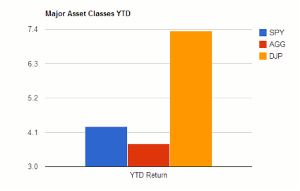Trading in trendless markets has always been challenging, so Jared Cummans of ETFdb.com highlights some asset classes that have been displaying trends this year.
2014 marks the fifth year of the current bull run, as markets try to extend their winning ways for a sixth consecutive 12-month stretch. Just last month, the S&P 500 cracked 1,900 for the first time, a major psychological level that a number of analysts took as a bullish sign. The year as a whole, however, has been relatively rocky, with equities struggling to maintain a definitive direction. This has led to a resurgence in interest in commodities and fixed income, two asset classes that mainly sat on the sidelines for the market run-up.
We took a look at these three asset classes (commodity, equity, and fixed income) to see where retail investors are investing in 2014 and how they are handling the general sense of uncertainty that currently plagues Wall Street. Here is what the net flows look like for the most popular broad ETF for each of the three major asset classes YTD (note, we used DJP rather than DBC as it provides a more all-encompassing commodity exposure while still maintaining a healthy liquidity):
Breaking Down the Results
Despite sitting near all-time highs, SPY has seen outflows of more than 12% thus far in 2014. This could be an indicator that retail investors are growing more wary of equity markets, but keep in mind that SPY is also a prime fund for traders; that result could also be influenced by heavy speculation on both the bullish and bearish side.
BND is the clear leader of the three major asset classes, as investors have begun to move into bonds. Often favored by retail investors and those with a longer timeline, this is likely a sign that the average investor is seeking fixed income as a safe haven to avoid some of the recent market volatility.
Finally, commodities have seen the largest outflow as a percentage of current assets in 2014. To some degree, this is influenced by traders, but DJP has less turnover than other commodity products, meaning it is more utilized by those with longer holding period. In other words, it appears that retail investors are also pulling away from their commodity investments.
To help put all of these flows in perspective, take a look at the YTD performance of each of these three products:
Despite seeing outflows in both equities and commodities, both asset classes are up on the year. What is even more surprising is that commodities are far ahead of their peers, yet have been subject to some heavy outflows. Bonds (as expected) have the lowest absolute return, as the fixed income asset class is much more stable than equities or commodities.
The Bottom Line
In no way are we suggesting that the trends provided by these ETFs can be applied as a surefire trend in the overall market. Instead, we utilized some of the most popular and all-encompassing funds in the world to help investors see some of the trends that the investment world is currently exhibiting. Take the numbers with a grain of salt, but also know that these are highly utilized funds, so these results do carry some weight.
By Jared Cummans, Contributor, ETFdb.com























